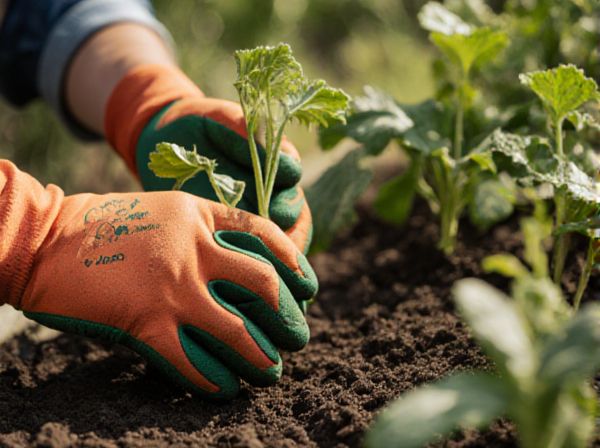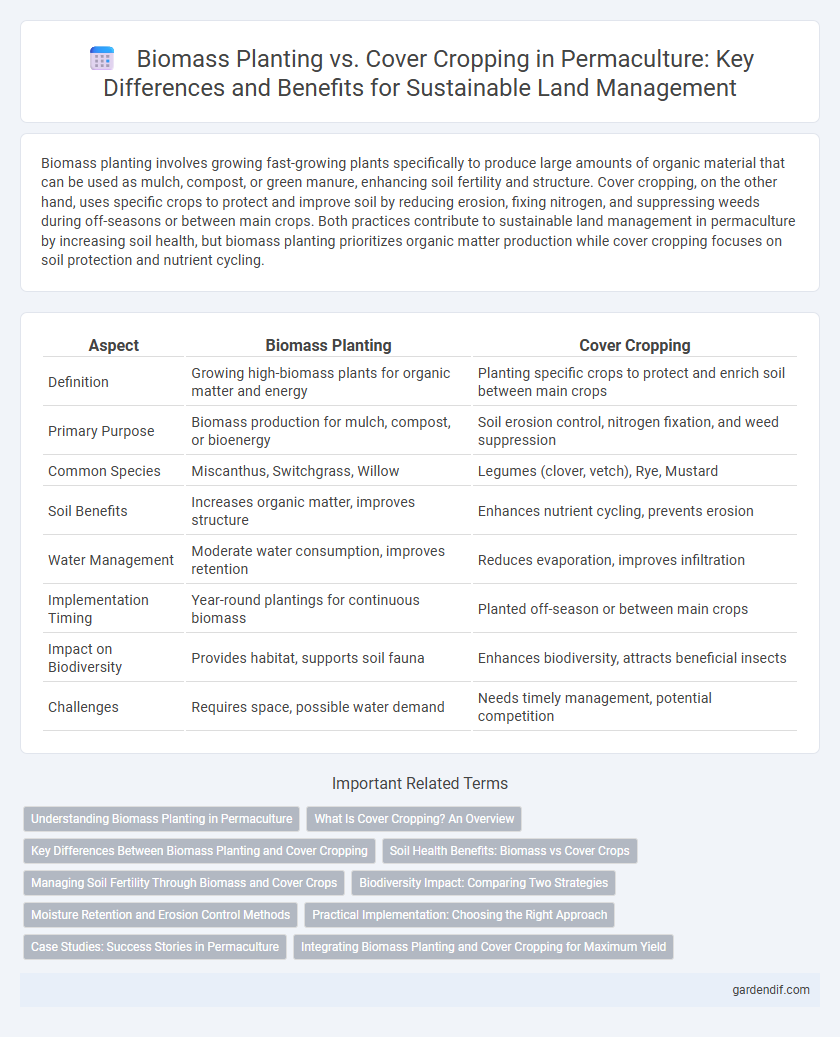
Biomass Planting vs Cover Cropping Illustration
Biomass planting involves growing fast-growing plants specifically to produce large amounts of organic material that can be used as mulch, compost, or green manure, enhancing soil fertility and structure. Cover cropping, on the other hand, uses specific crops to protect and improve soil by reducing erosion, fixing nitrogen, and suppressing weeds during off-seasons or between main crops. Both practices contribute to sustainable land management in permaculture by increasing soil health, but biomass planting prioritizes organic matter production while cover cropping focuses on soil protection and nutrient cycling.
Table of Comparison
| Aspect | Biomass Planting | Cover Cropping |
|---|---|---|
| Definition | Growing high-biomass plants for organic matter and energy | Planting specific crops to protect and enrich soil between main crops |
| Primary Purpose | Biomass production for mulch, compost, or bioenergy | Soil erosion control, nitrogen fixation, and weed suppression |
| Common Species | Miscanthus, Switchgrass, Willow | Legumes (clover, vetch), Rye, Mustard |
| Soil Benefits | Increases organic matter, improves structure | Enhances nutrient cycling, prevents erosion |
| Water Management | Moderate water consumption, improves retention | Reduces evaporation, improves infiltration |
| Implementation Timing | Year-round plantings for continuous biomass | Planted off-season or between main crops |
| Impact on Biodiversity | Provides habitat, supports soil fauna | Enhances biodiversity, attracts beneficial insects |
| Challenges | Requires space, possible water demand | Needs timely management, potential competition |
Understanding Biomass Planting in Permaculture
Biomass planting in permaculture involves cultivating fast-growing plants specifically to produce organic matter that enriches soil fertility and enhances microbial activity. Unlike cover cropping, which primarily prevents erosion and improves soil structure during off-seasons, biomass planting focuses on generating substantial organic input for mulching and composting. This strategy supports sustainable nutrient cycling and promotes long-term soil health by continuously adding carbon-rich biomass to the ecosystem.
What Is Cover Cropping? An Overview
Cover cropping involves cultivating specific plants such as clover, rye, or vetch to protect and enrich the soil between main crop cycles. This practice enhances soil fertility by fixing nitrogen, suppresses weeds, reduces erosion, and increases organic matter through biomass incorporation. In permaculture systems, cover cropping supports sustainable land management by improving soil structure and promoting biodiversity.
Key Differences Between Biomass Planting and Cover Cropping
Biomass planting in permaculture primarily aims to produce large amounts of organic material for soil amendment, often utilizing fast-growing species like legumes and grasses to enhance soil fertility and carbon content. Cover cropping focuses on protecting and improving soil health by preventing erosion, suppressing weeds, and increasing microbial activity through diverse plant species that remain in place during off-seasons. Key differences include biomass planting's emphasis on harvesting organic matter for composting versus cover cropping's role in living soil cover and nutrient cycling without regular biomass removal.
Soil Health Benefits: Biomass vs Cover Crops
Biomass planting significantly enhances soil structure by increasing organic matter, promoting microbial diversity, and improving nutrient cycling essential for sustainable permaculture systems. Cover cropping prevents soil erosion, suppresses weeds, and fixes nitrogen, directly boosting soil fertility and moisture retention. Both methods synergistically support long-term soil health, reducing reliance on synthetic inputs and fostering resilient agroecosystems.
Managing Soil Fertility Through Biomass and Cover Crops
Biomass planting enhances soil fertility by producing large amounts of organic matter that improve soil structure and nutrient cycling, while cover cropping protects soil from erosion and fixes nitrogen through legumes. Integrating both practices maximizes nutrient availability and supports microbial activity, essential for healthy, resilient soil ecosystems in permaculture systems. Effective management of biomass and cover crops reduces the need for synthetic fertilizers and promotes sustainable soil regeneration.
Biodiversity Impact: Comparing Two Strategies
Biomass planting enhances biodiversity by introducing diverse plant species that provide habitats and food sources for various insects and wildlife, supporting ecosystem resilience. Cover cropping improves soil health and promotes microbial diversity, reducing erosion and nutrient loss while encouraging beneficial insect populations. Both strategies contribute uniquely to biodiversity, with biomass planting focusing on above-ground habitat complexity and cover cropping emphasizing soil ecosystem vitality.
Moisture Retention and Erosion Control Methods
Biomass planting enhances soil moisture retention by adding substantial organic matter that improves soil structure and water-holding capacity. Cover cropping prevents erosion effectively through continuous ground cover, reducing soil displacement by wind and water. Both methods contribute to sustainable soil management, with biomass planting primarily boosting moisture retention and cover cropping excelling in erosion control.
Practical Implementation: Choosing the Right Approach
Selecting between biomass planting and cover cropping depends on soil goals and site conditions; biomass planting prioritizes rapid organic matter accumulation through fast-growing species like sunflowers and sorghum, enhancing carbon sequestration and nutrient cycling. Cover cropping utilizes legumes, clover, or rye to improve soil fertility, prevent erosion, and suppress weeds, contributing nitrogen through biological fixation. Farmers should assess soil health, crop rotation plans, and desired ecosystem services to determine the most effective strategy for sustainable permaculture systems.
Case Studies: Success Stories in Permaculture
Case studies in permaculture highlight that biomass planting significantly boosts soil organic matter by producing large volumes of organic residues, enhancing long-term soil fertility. Research from permaculture farms in Kenya shows biomass species like comfrey and mulberry improved nutrient cycling and moisture retention more effectively than traditional cover crops. Conversely, cover cropping success in temperate zones, such as in Oregon, demonstrates improved weed suppression and erosion control, proving its value in annual crop rotations within permaculture systems.
Integrating Biomass Planting and Cover Cropping for Maximum Yield
Integrating biomass planting with cover cropping enhances soil fertility by combining deep-rooted plants that mobilize nutrients and surface cover crops that prevent erosion and suppress weeds. This synergy improves organic matter content, moisture retention, and microbial activity, optimizing nutrient cycling for higher crop yields. Strategic selection of complementary species in biomass and cover crops maximizes these benefits, promoting sustainable productivity in permaculture systems.
Biomass Planting vs Cover Cropping Infographic

 gardendif.com
gardendif.com